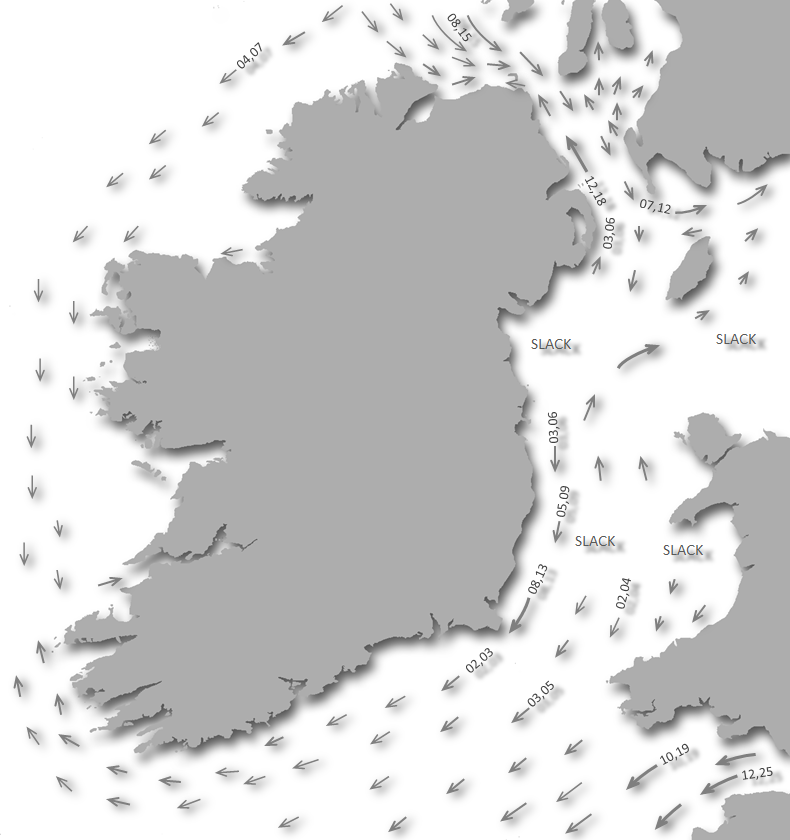
Portkill is an exposed anchorage with shelter and protection from west to south. It is not recommended for an overnight stop which can sometimes be uncomfortable. The bay, although available at all states of the tide, requires attentive navigation for access and keen eyeball navigation to pass in through fringing rocky outcrops.
Keyfacts for Portkill
Facilities

Nature







Considerations

Protected sectors
Approaches


Shelter


Last modified
February 19th 2020 Summary
An exposed location with attentive navigation required for access.Facilities

Nature







Considerations

Position and approaches
Expand to new tab or fullscreen
Haven position
 55° 14.410' N, 006° 55.817' W
55° 14.410' N, 006° 55.817' WThis is the anchorage location off the beach.
What is the initial fix?
The following Portkill Initial Fix will set up a final approach:
 55° 14.470' N, 006° 55.350' W
55° 14.470' N, 006° 55.350' W What are the key points of the approach?
Offshore details are available in the northeast Ireland’s Coastal Overview for Malin Head to Strangford Lough  .
.
 .
.- Lough Foyle’s approaches, the run up the lough to the River Foyle and beyond are detailed in the Foyle Port Marina (Derry City)
entry.
- Align on the grey standing stone and track in on 257°T using keen eyeball navigation.
Not what you need?
Click the 'Next' and 'Previous' buttons to progress through neighbouring havens in a coastal 'clockwise' or 'anti-clockwise' sequence. Below are the ten nearest havens to Portkill for your convenience.
Ten nearest havens by straight line charted distance and bearing:
- Portnocker - 0.6 nautical miles SSE
- White Bay - 0.8 nautical miles S
- Cornashamma Bay - 1.8 nautical miles SSW
- Silver Strand - 2.2 nautical miles SSW
- Kinnagoe Bay - 2.9 nautical miles WNW
- Greencastle - 3 nautical miles SW
- Magilligan Point - 3.3 nautical miles SSW
- Moville - 5 nautical miles SW
- Tremone Bay - 5.2 nautical miles WNW
- Carrickarory Pier - 5.6 nautical miles SW
These havens are ordered by straight line charted distance and bearing, and can be reordered by compass direction or coastal sequence:
- Portnocker - 0.6 miles SSE
- White Bay - 0.8 miles S
- Cornashamma Bay - 1.8 miles SSW
- Silver Strand - 2.2 miles SSW
- Kinnagoe Bay - 2.9 miles WNW
- Greencastle - 3 miles SW
- Magilligan Point - 3.3 miles SSW
- Moville - 5 miles SW
- Tremone Bay - 5.2 miles WNW
- Carrickarory Pier - 5.6 miles SW
Chart
What's the story here?
 Anchored in Portkill
Anchored in PortkillImage: Andrew Cameron-Mitchell
Portkill is a small secluded beach on the Inishowen Peninsula situated less than half a mile to the northwest of Inishowen Head. It has the remains of an early ecclesiastical site dedicated to Colmcille, containing a holy well called Colmcille's Well and a cross-inscribed pillar stone dating possibly from the 8th-century.
How to get in?
 Lough Foyle’s approaches, as detailed in the Foyle Port Marina (Derry City)
Lough Foyle’s approaches, as detailed in the Foyle Port Marina (Derry City)  entry, provide general approach directions to the area.
entry, provide general approach directions to the area. The Portkill Initial fix is a quarter of a mile north of Inishowen Head and is 800 metres out from the standing stone on the shore. The position sets up an approach between two off-lying rocky outcrops off the beach.
The Portkill Initial fix is a quarter of a mile north of Inishowen Head and is 800 metres out from the standing stone on the shore. The position sets up an approach between two off-lying rocky outcrops off the beach. Align on the grey standing stone marked on Admiralty chart No. 2511. Keeping this on a bearing of 257° T for a distance of 500 metres from the initial fix will lead into the anchoring area through the rocky outcrops. The final few metres that lead into the small anchorage require keen eyeball navigation, and a steady pace with a keen eye to the sounder all the way.
 Anchor according to draft and prevailing conditions. Holding is very good in sand. Land on the beach by dingy.
Anchor according to draft and prevailing conditions. Holding is very good in sand. Land on the beach by dingy.Why visit here?
Portkill derives its name from the Irish ‘Port-cille’, a shortened form of ‘Port Colmcille’ or 'Colmcille's port'. It refers to St. Colm Cille, Donegal’s most famous saint.
In 563 A.D., en route to Scotland by ‘curragh’ from Derry, he and his accompanying 11 monks called in at Portkill to take in water from the spring on the beach. After coming ashore St. Columcille climbed the bank to the top of the hill. There he took one last look at his beloved homeland called Cnoc an Leactha above. Having said farewell to his beloved Derry, he returned to the shore where he blessed the well and cut the cross on the stone with his finger.

Today Portkill has changed little. Immediately up from the beach on a flat grassy patch, the eighth-century standing stone can be found. Made of hard grey sedimentary stone it has a rough cross inscribed on its western face - five small deep hollows mark the crossing and the ends of the cross. Nearby a wooden cross will also be seen.
The holy well that is dedicated to St. Columcille is located a few metres inshore of the standing stone. The well, or more appropriately spring, is very small measuring only 25 x 32 cm wide and is less than 10 cm deep with loose gravel and shell at the bottom. With no structure, it is often hidden or overgrown with vegetation. However, a small concrete cross has been erected above it bearing the date 1937. Close to the well, there are bushes where people tie a ribbon or a rag during the local communities’ annual pilgrimage made on the 15th August to early September. These tokens are healing wishes for a sore, rubbed on the rag, or bruises, warts, and an infinite variety of ailments and intentions. Likewise, there were always a lot of coins in the area.
The road above may be reached via a scrambling climb up a high steep bank. While it is possible to ascend the 120 metres, 400 foot, hill from the beach, this can in no way be classed as a safe climb. But those who take on the climb will be rewarded with a magnificent viewpoint above Portkill. A stone picnic bench and a seat are situated there to fully take in the surroundings, including a spectacular view of Inishowen Lighthouse.
From a purely boating point of view, Portkill is a small, secluded and beautiful beach beneath a steep cliff and mountain pasture. It has no facilities and is exposed but it offers another culturally interesting point to visit on the beautiful Inishowen Peninsula.
What facilities are available?
Portkill is a secluded and remote bay with no facilities ashore save for an access road.Any security concerns?
Never an issue known to have occurred to a vessel anchored in Portkill.With thanks to:
Bill McCann, Londonderry Harbour Master. Photography with thanks to Patrick Mackie, Kay Atherton and Kenneth Allen.Add your review or comment:
Please log in to leave a review of this haven.
Please note eOceanic makes no guarantee of the validity of this information, we have not visited this haven and do not have first-hand experience to qualify the data. Although the contributors are vetted by peer review as practised authorities, they are in no way, whatsoever, responsible for the accuracy of their contributions. It is essential that you thoroughly check the accuracy and suitability for your vessel of any waypoints offered in any context plus the precision of your GPS. Any data provided on this page is entirely used at your own risk and you must read our legal page if you view data on this site. Free to use sea charts courtesy of Navionics.












